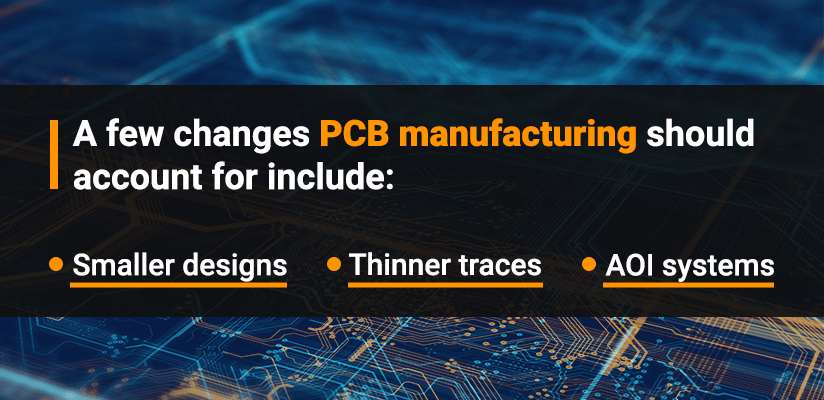According to industry experts, 40% of the global population will utilize 5G networks by 2024. This increased demand will cause multiple changes for consumers, retailers and component designers, including printed circuit board (PCB) manufacturers. Learn more about 5G and its impact on PCB materials and production.
What Is 5G?
5G is the fifth generation of mobile broadband technology and is available in low-band, mid-band and high-band variations. This emerging tech uses cell sites divided into separate units that send encoded data via radio waves through wired and wireless connections.
Compared to 4G, 5G offers:
- High speeds: Because of its larger channels, 5G is far faster than preceding networks, responding to user requests in less than a second. Compared to 4G’s 1 Gigabits per second (Gbps) peak speed, 5G can reach an estimated 20 Gbps at its fastest.
- Lower latency: 5G networks are currently sub-6 GHz or mmWave, making them more responsive than a 4G-only network. This improves the user experience and allows the technology to work in industries and applications with stronger demand for reliability.
- Increased connectivity: 5G’s increased speeds and reduced latency create a stronger connection that opens 5G-enabled technology to more cloud software, machine-learning tools and smart devices and sensors.
- Better reach: One of the most significant advantages of 5G connectivity is the improved reach for communications and cellular-to-WiFi roaming. 5G networks can access areas once cut off from digital connections, bringing critical technology to lifesaving industries.
Though different from 4G technology, 5G is not a complete replacement for it. In 5G’s current state, most enabled devices still need 4G coverage for optimal performance.
Why Is 5G Important for PCBs?
These connection improvements change the landscape for 5G PCB design. As 5G becomes more widely used, demand increases, raising the standard for adaptable PCB design. While 4G PCBs utilize a baseband unit, remote radio unit, antenna, copper wire and fiber optics, 5G PCBs have centralized and decentralized units with broadband control units and mobile edge computing. 5G PCBs also require more base stations because — despite higher frequencies — more coverage and antennas are needed.
PCB designers, manufacturers and other industry engineers can’t afford to ignore 5G, as it will soon affect every area of the production process:
- Customer awareness: As customers become more aware of 5G coverage and 5G-enabled devices are more readily available on the market, PCB manufacturers must take steps to keep up with the increased and evolving demands from the consumer market. Technologies — and the processes and equipment used to support them — must be quickly adaptable as 5G networks change and expand to more areas and devices.
- Data traffic: Experts predict 5G to handle one-quarter of all mobile data traffic by 2024 thanks to its speed, low latency, versatility and reliability. This data will include video, mobile gaming, telecommunication and browser and application use. This spike in data traffic demands PCB manufacturers and device designers streamline existing processes and establish new ones to maintain reliable performance free of lagging data transmission or spotty connectivity.
- Industry applications: You often hear 5G terminology used when discussing smartphones and other user electronics, but these improvements have expanded 5G coverage into multiple sectors, including the health care, automotive, manufacturing, retail, entertainment and communication industries. Wider usage equates to a higher demand for PCB technology and PCB manufacturers by extension. It also introduces modern-day PCB innovations into industries that aren’t currently using technology to its fullest potential, like agriculture, widening the scope for both 5G and PCBs.
How 5G Will Affect PCB Manufacturers
PCB manufacturers can keep up with this rapidly evolving technology by implementing design, material, procedural and production processes that will continue to grow with 5G technology. A few changes PCB manufacturing should account for include:
- Smaller designs: Consumer electronics, including smartphones, wearable fitness devices and smart speakers, are always changing as manufacturers compete with various innovations and bold design choices. Consider the latest trend of foldable smartphones. Traditional PCBs are too rigid, so more flexible 5G PCB materials must be considered. Devices are also becoming more powerful and compact, requiring smaller, thinner PCBs that do not sacrifice performance, especially as new features and trends hit the market.
- Thinner traces: Many 5G devices require high-density interconnect (HDI) PCBs because they have thinner traces to prevent lost signals and delayed transmissions. Traditional PCB processes, including subtractive design, can create crossed tracks on the PCB that interfere with 5G performance. Manufacturers can combat this by using a semi-additive fabrication process (mSAP) to create straighter, more precise traces for maximum circuit density.
- AOI systems: Advanced automated optical inspection systems (AOIs) inspect PCBs during the manufacturing process to detect, identify and repair any issues — either in design, performance or comparison to the intended design — before moving on to mass production. They are superior to manual inspection because they require minimal time and employee involvement. Manufacturing facilities should optimize their AOI processes and condense them to as few platforms as possible to continue conserving resources and floor space. 5G requires even more sophisticated AOI systems to catch and correct even small misalignments to isolate issues faster.
The Challenges and Opportunities of 5G for PCBs
As 5G becomes a more prominent part of PCB manufacturing, producers are likely to encounter several challenges and opportunities.
Challenges of 5G PCB Technology
Two significant challenges for 5G PCB designs deal with the antenna box and thermal management materials:
- Antenna box: 5G technology utilizes extremely high frequency (EHF), which requires more base stations and array antennas to operate effectively. PCB manufacturers will need to create a larger active antenna box to house these multiple antenna array units (AAU).
- Thermal management: Because 5G outputs more power and speed with reduced latency, manufacturers need to analyze existing materials and make design changes that promote better thermal management. This includes heat dissipating structures and materials with low dielectric constants to eliminate lost signals and prevent PCB breakdown.
5G PCB Opportunities
For consumers, adapting PCB designs to accommodate 5G networks has clear advantages — a device that performs better and has more innovative features without performance issues slowing its system down. While manufacturers may enjoy similar benefits across various production equipment, the most significant benefit comes from consumer demand.
The PCB market will continue to grow due to the rising demand for more powerful, adaptable devices and the components that power them. As more consumers across industries migrate toward 5G devices, the need for PCBs will naturally grow with it.
In addition to meeting consumer demand and achieving better profits, production facilities that have the tools and processes in place to adapt with technology — instead of lagging behind it — will continue to grow as trends change and coverage expands.
Contact Millennium Circuits to Learn More
Though 5G broadband is still securing its place in the world of digital devices and connectivity, its faster speeds, improved user experience and reliability will have a lasting effect on the PCB industry. Manufacturers should strive to refine processes and resources to keep your business competitive and adaptable by using more thermal-resistant materials and shifting designs to create better signals and reduce lagging performance.
Explore our products and services or contact Millennium Circuits to learn more about how 5G may impact your project.




